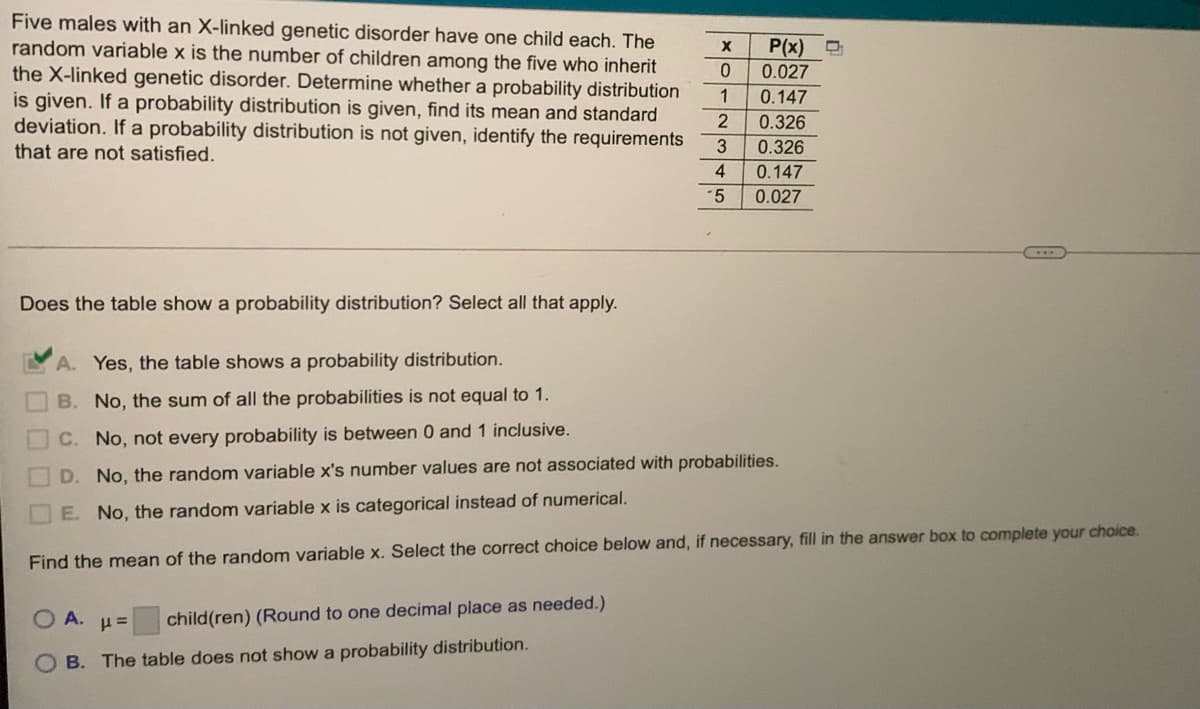Five males with an X-linked genetic disorder have one child each. The random variable x is the number of children among the five who inherit the X-linked genetic disorder. Determine whether a probability distribution is given. If a probability distribution is given, find its mean and standard deviation. If a probability distribution is not given, identify the requirements that are not satisfied. P(x) 0.027 0.147 0.326 0.326 4 0.147 -5 0.027 Does the table show a probability distribution? Select all that apply. A. Yes, the table shows a probability distribution. B. No, the sum of all the probabilities is not equal to 1. UC. No, not every probability is between 0 and 1 inclusive. O D. No, the random variable x's number values are not associated with probabilities. OE. No, the random variable x is categorical instead of numerical. Find the mean of the random variable x. Select the correct choice below and, if necessary, fill in the answer box to complete your cha O A. child(ren) (Round to one decimal place as needed.) B. The table does not show a probability distribution.
Five males with an X-linked genetic disorder have one child each. The random variable x is the number of children among the five who inherit the X-linked genetic disorder. Determine whether a probability distribution is given. If a probability distribution is given, find its mean and standard deviation. If a probability distribution is not given, identify the requirements that are not satisfied. P(x) 0.027 0.147 0.326 0.326 4 0.147 -5 0.027 Does the table show a probability distribution? Select all that apply. A. Yes, the table shows a probability distribution. B. No, the sum of all the probabilities is not equal to 1. UC. No, not every probability is between 0 and 1 inclusive. O D. No, the random variable x's number values are not associated with probabilities. OE. No, the random variable x is categorical instead of numerical. Find the mean of the random variable x. Select the correct choice below and, if necessary, fill in the answer box to complete your cha O A. child(ren) (Round to one decimal place as needed.) B. The table does not show a probability distribution.
College Algebra
7th Edition
ISBN:9781305115545
Author:James Stewart, Lothar Redlin, Saleem Watson
Publisher:James Stewart, Lothar Redlin, Saleem Watson
Chapter9: Counting And Probability
Section9.3: Binomial Probability
Problem 2E: If a binomial experiment has probability p success, then the probability of failure is...
Related questions
Question
Also find the standard deviation

Transcribed Image Text:Five males with an X-linked genetic disorder have one child each. The
random variable x is the number of children among the five who inherit
the X-linked genetic disorder. Determine whether a probability distribution
is given. If a probability distribution is given, find its mean and standard
deviation. If a probability distribution is not given, identify the requirements
that are not satisfied.
P(x)
0.027
0.147
0.326
1
0.326
4.
0.147
0.027
Does the table show a probability distribution? Select all that apply.
A. Yes, the table shows a probability distribution.
B. No, the sum of all the probabilities is not equal to 1.
C. No, not every probability is between 0 and 1 inclusive.
D. No, the random variable x's number values are not associated with probabilities.
E. No, the random variable x is categorical instead of numerical.
Find the mean of the random variable x. Select the correct choice below and, if necessary, fill in the answer box to complete your choice.
O A.
child(ren) (Round to one decimal place as needed.)
O B. The table does not show a probability distribution.
Expert Solution
Step 1
Properties of probability distribution:
- The total probability of the distribution should be 1.
- Each probability of the distribution should lie between 0 and 1 inclusive.
Trending now
This is a popular solution!
Step by step
Solved in 2 steps with 1 images

Recommended textbooks for you

College Algebra
Algebra
ISBN:
9781305115545
Author:
James Stewart, Lothar Redlin, Saleem Watson
Publisher:
Cengage Learning

College Algebra
Algebra
ISBN:
9781305115545
Author:
James Stewart, Lothar Redlin, Saleem Watson
Publisher:
Cengage Learning